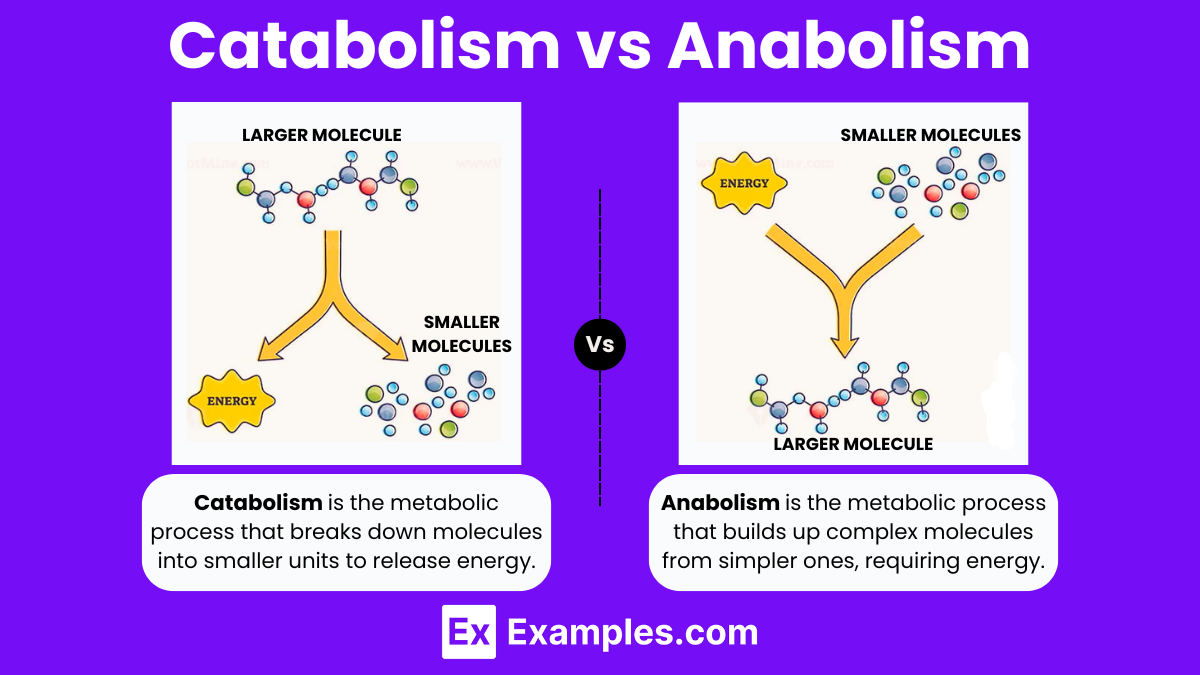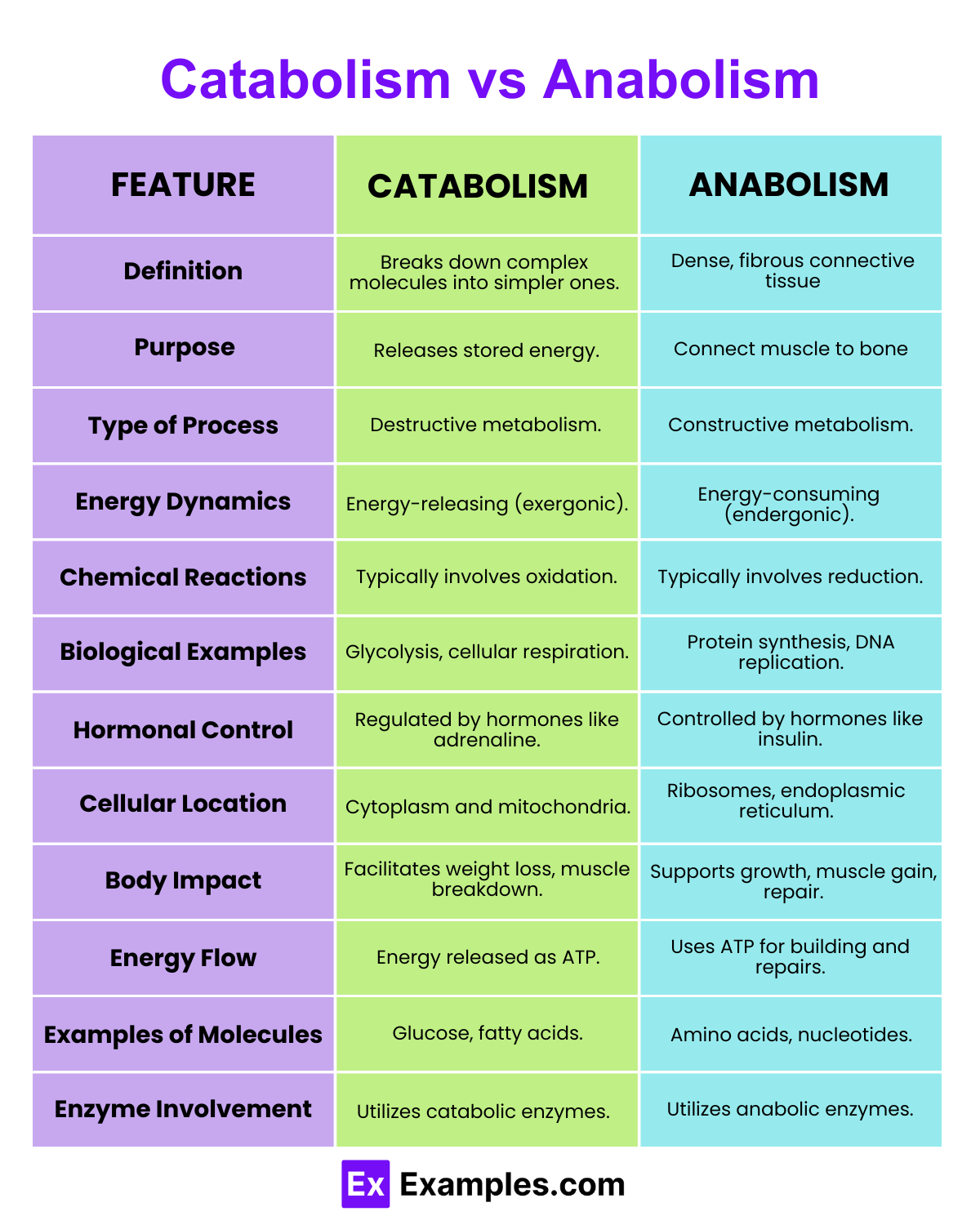Which metabolic process involves the breakdown of molecules to release energy?
Anabolism
Catabolism
Photosynthesis
Glycolysis


Metabolism is a fundamental biological process that drives growth, development, and the efficient functioning of the body. It consists of two interconnected pathways: catabolism and anabolism, each playing a pivotal role in cellular and systemic activities. Catabolism involves the breakdown of complex molecules into simpler ones, releasing energy that the body uses for various functions. Conversely, anabolism focuses on building necessary molecules and typically requires energy input. Understanding the distinct roles and interactions between catabolism and anabolism is essential for grasping how the body maintains balance and supports life. This will delve into the differences and interplay between these two metabolic pathways.
Catabolism is a series of metabolic processes that occur within living organisms where large molecules such as proteins, carbohydrates, and fats are broken down into smaller units like amino acids, sugars, and fatty acids, respectively. This breakdown releases energy, which is captured in the form of ATP (adenosine triphosphate), the main energy currency of the cell. Catabolic reactions are crucial for providing the necessary energy to fuel various cellular activities, including movement, cell division, and synthesis of new molecules. These reactions also generate the basic building blocks needed for cell repair and growth, playing a vital role in maintaining the body’s overall metabolism and health.
An example of catabolism is the process of cellular respiration, where cells break down glucose to produce energy. During this metabolic pathway, enzymes in the mitochondria rapidly convert glucose molecules into carbon dioxide, water, and ATP (adenosine triphosphate). This reaction not only provides the necessary energy to power various cellular activities but also generates heat to maintain body temperature. Cellular respiration epitomizes catabolism by efficiently dismantling complex molecules to release and harness energy.
Anabolism is a metabolic pathway that involves the synthesis of complex molecules from simpler ones, crucial for cellular growth, repair, and maintenance. This energy-consuming process helps build essential components such as proteins, nucleic acids, and lipids, which are vital for cell structure and function. Anabolic reactions require energy, typically derived from ATP, to form bonds between molecules, leading to the construction of larger and more complex structures. This process is fundamental in supporting the body’s growth and the continuous renewal of cells, enabling organisms to thrive, reproduce, and maintain their structures against environmental challenges.
One example of anabolism is the synthesis of proteins from amino acids. In this process, cells actively link amino acids together in a specific sequence dictated by DNA, forming a polypeptide chain that folds into a functional protein. This protein synthesis is essential for cell growth, repair, and the maintenance of body tissues, and it occurs continuously in the cells of all living organisms.

| Aspect | Catabolism | Anabolism |
|---|---|---|
| Definition | Catabolism refers to the metabolic process that breaks down molecules into smaller units, releasing energy in the process. | Anabolism involves the metabolic process that builds up larger molecules from smaller ones, utilizing energy. |
| Type of Reaction | These are typically degradative reactions. | These are synthetic reactions. |
| Energy | Catabolic pathways release energy by breaking down complex molecules. | Anabolic pathways require energy to synthesize complex molecules. |
| Examples of Molecules Broken Down or Synthesized | Glucose, fatty acids, and proteins are broken down into smaller units like carbon dioxide, water, and ammonia. | Simple molecules like amino acids, monosaccharides, and fatty acids are used to synthesize proteins, polysaccharides, and lipids. |
| Role in Cellular Activities | Catabolism provides the necessary energy and small subunits required for cellular activities. | Anabolism utilizes energy to construct components of cells such as proteins and nucleic acids. |
| Impact on Body Weight | Catabolic processes can lead to a decrease in body weight as they involve the breakdown of molecules. | Anabolic processes are associated with weight gain, as they generally promote the growth of body tissues. |
| Hormonal Influences | Hormones like adrenaline and glucagon promote catabolism. | Hormones such as insulin, growth hormone, and testosterone stimulate anabolism. |
| Examples of Pathways | Glycolysis and the citric acid cycle are classic examples of catabolic pathways. | Protein synthesis and DNA replication are examples of anabolic pathways. |
| Physiological Conditions | Often enhanced during exercise or fasting when energy is required. | Predominantly occurs during rest and recovery when the body is building and repairing tissues. |
| Biochemical Outcomes | Results in the production of ATP, which is used as energy currency in cells. | Leads to the production of complex molecules like starch, glycogen, lipids, and proteins. |
| Enzymatic Regulation | Involves enzymes that catalyze the breakdown of complex molecules into simpler ones, which are often regulated by negative feedback. | Involves enzymes that aid in the synthesis of complex molecules, regulated by both positive and negative feedback mechanisms. |
| Storage Forms Affected | Involves the breakdown of stored carbohydrates, fats, and proteins. | Involved in the storage of excess nutrients by converting them into more complex forms. |
| Cellular Location | Many catabolic processes occur in the mitochondria, where ATP is generated. | Anabolic processes occur in various sites, such as cytoplasm (protein synthesis) and smooth endoplasmic reticulum (lipid synthesis). |
| Overall Effect on Metabolism | Typically speeds up metabolism due to the energy release function. | Generally slows down metabolism as energy is used to build and store complex molecules. |
Catabolism and anabolism are both integral components of metabolism, the complex network of biochemical reactions that maintain life within an organism. Here are some key similarities between these two processes
Catabolism breaks down molecules for energy; anabolism builds complex molecules from simpler ones, using energy.
Anabolism: Protein synthesis from amino acids. Catabolism: Glucose breaking down into water and carbon dioxide during respiration.
Recall: Catabolism Crushes for energy and Anabolism Adds to build up molecules.
An example of catabolism is glycolysis, where glucose is broken down into pyruvate, releasing energy.
Examples include protein synthesis, DNA replication, and the synthesis of complex carbohydrates like starch.
Text prompt
Add Tone
10 Examples of Public speaking
20 Examples of Gas lighting
Which metabolic process involves the breakdown of molecules to release energy?
Anabolism
Catabolism
Photosynthesis
Glycolysis
Which of the following is an example of an anabolic process?
Cellular respiration
Protein synthesis
Glycolysis
Lipolysis
What is the primary goal of catabolic reactions?
To store energy
To release energy
To synthesize complex molecules
To repair tissues
Which process is characterized by the synthesis of complex molecules from simpler ones?
Catabolism
Anabolism
Metabolism
Fermentation
In which of the following processes is ATP typically consumed?
Catabolic reactions
Anabolic reactions
Digestion
Respiration
Which term describes the process of breaking down glucose to produce ATP?
Anabolism
Catabolism
Catabolism
Biosynthesis
Which metabolic pathway would be active during muscle growth and repair?
Catabolic pathways
Anabolic pathways
Glycolysis
Citric acid cycle
What happens to ATP during catabolic reactions?
It is consumed
It is produced
It is broken down into ADP
It is synthesized from ADP
Which of the following is a characteristic of anabolic reactions?
Release of energy
Degradation of molecules
Synthesis of complex molecules
Production of carbon dioxide
How do catabolic and anabolic processes relate to each other in metabolism?
They are independent and unrelated
They operate in a sequential manner where catabolism provides energy for anabolism
They both consume ATP
They both break down molecules
Before you leave, take our quick quiz to enhance your learning!

